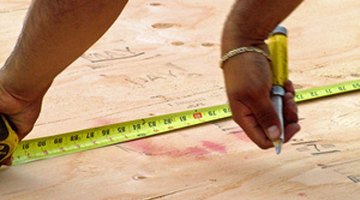Types of Wood to Fix a Hole in the Shed
In addition to being unsightly, a hole in the shed can be a source for leaks and an entry-point for scavenging animals like squirrels and raccoons. Both water and the gnawing teeth of these animals can cause damage to the equipment you store there, such as lawn mowers and weed-whackers. Fortunately, you can easily repair a shed hole with wood and screws. If you are thinking of undertaking a hole-repairing project, make sure to consider the best types of wood available for the job.
Plywood

Plywood is a strong, inexpensive material, which consists of multiple layers of thin wooden boards, or plies. Manufacturers compress and glue these plies together, alternating the grain direction of each layer as they go to increase strength. According to the educational resource website Design Technologies, you can use plywood in outdoor construction applications—such as patching a hole in a shed—however, for optimal results they recommend an exterior grade or weather and boil proof (WBP) variety. These types of plywood feature moisture-resistant adhesives between their plies. However, they WBP plywood must be painted to protect it from the elements.
Treated Lumber
While plywood is a viable option when it comes to repairing a hole in the wall of shed, when it comes to the floor of a shed, it is inadequate. As the home improvement and construction Web site Ask The Builder notes, plywood that is continuously in contact with the moist ground will eventually succumb to decay. A solution to this problem is to use chemically-treated lumber.
Treated lumber is wood, such as Douglas fir and southern pine, or plywood, which manufacturers infuse with either water-borne or oil-borne preservatives. The most resilient type of treated lumber, according to the Iowa State University Extension, is pressured-treated because preservatives are able to penetrate more evenly and deeply into the wood’s grains, providing protection from moisture.
Cedar
As Iowa State University mentions, cedar trees have incredibly durable heart-woods, or internal wood fibers, which can naturally resist the rot-inducing effects of moisture. This makes cedar wood, such as western red cedar, a good choice for patching a hole in a wooden deck, even if it is in the flooring. In addition, the wood can regulate its water content. According to the wooden spa enclosure and gazebo Web site Alliance Woodcraft, western red cedar is hygroscopic, which means it always maintains a water-content equilibrium, absorbing and expelling moisture as necessary.
Redwood
Like cedar, redwood has internal heart-wood that is naturally immune to rot, making it a good choice for shed repairs. And while redwood has a higher fiber density than cedar, making it structurally stronger; redwood is prone to splitting and cracking, especially when you tighten screws into it.
References
Resources
Writer Bio
Erik Devaney is a writing professional specializing in health and science topics. His work has been featured on various websites. Devaney attended McGill University, where he earned a Bachelor of Arts in humanistic studies.
Photo Credits
- construction ,measuring image by Greg Pickens from Fotolia.com
More Articles



